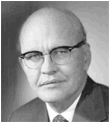Jack St. Clair Kilby
Born November 8, 1923, Jefferson City, Mo.; co-inventor in 1958 of the integrated computer chip (the "IC").

Education: BS, University of Illinois, 1947; MS, University of Wisconsin, 1950.
Professional Experience: engineer, Globe-Union, Inc., Wis., 1947-1958; Texas Instruments, Inc.: engineer, assistant vice president, 1958-1970; consultant, 1970-present; distinguished professor, Texas A&M, 1977-present.
Honors and Awards: Outstanding Electrical Engineer Award, Dallas Section, IEEE, 1965; David Sarnoff Award, IEEE, 1966; fellow, IEEE, 1966 ["For contributions to the field of integrated circuits through basic concepts, inventions, and development."] ; National Inventors Hall of Fame, Sarnoff Award, IEEE, 1966; Ballantine Medal, Franklin Institute, 1966; Hall Minuteman Trophy, Order of Daeclalians, 1966; member, National Academy of Engineering, 1967; National Medal of Science, 1969; Zworykwin Medal, National Academy of Engineering, 1975; Alumni Achievement Award, University of Illinois, 1975; member, National Academy of Engineering; Cledo Brunetti Award, IEEE, 1979; IEEE Consumer Electronics Award, 1980; Holley Award, American Society of Mechanical Engineers (ASME), 1982; National Inventors Hall of Fame, 1982; DEng (Hon.), University of Miami, 1982; member, Information Processing Hall of Fame, Infomart, Dallas, Texas, 1985; DEng (Hon.), Rochester Institute of Technology, 1986; IEEE Medal of Honor, 1986; DSci (Hon.), University of Illinois, 1988; US Department of Commerce, Medal of Technology, 1990; Kyoto Prize, Advanced Technology, 1993; IEEE Pioneer Award, 1993.
Kilby was the first person in the world to propose and corroborate the fundamental concept of the monolithic semiconductor integrated circuit (IC that laid the foundation for today's leading-edge technology of LSI and VLSI chips. Further, he contributed greatly to the early state of monolithic IC development and its practical application. His pioneering contribution was a great asset to the development of microelectronics.
Following a seminar at Bell Telephone Laboratories which he attended in 1952, Kilby turned his attention to the development of hearing aids for the deaf, based on germanium transistor technology. He soon found that silicon would be an improved base for the construction of transistors, but that his employer, Globe-Union, Inc., was committed to germanium. He found employment at Texas Instruments, Inc., and under their imprimatur was able to develop a new evolutionary progression beyond the solid-state technology. Kilby conceived and proved his idea of integrating a transistor with resistors and capacitors on a single semiconductor chip, which is a monolithic IC. His idea of a monolithic IC, together with the planar technology of Jean Hoerni and the late Robert Noyce's idea of "Junction isolation" for planar interconnections, underpins the great progress of today's semiconductor IC and the microelectronics based upon it. Texas Instruments filed a patent application and filed a lawsuit against Robert Noyce and Fairchild Industries for infringement. In 1969 the courts ruled in favor of Noyce. It is generally agreed, in hindsight, that Kilby built the first integrated circuit, while Noyce provided a practical implementation that could be commercialized.
Kilby's achievements can be summarized as follows:
Original Concept and Corroboration of the Monolithic Semiconductor Integrated Circuit
In 1958, during the development of miniature packaging technology for electronic circuits, Kilby conceived the idea of fabricating all electronic components on the same piece of semiconductor material. He developed and operated the first hybrid IC prototype in which the electric circuit components, other than the inductor, consisted of semiconductor components connecting resistors made of semiconductor bulk and capacitors of pn junctions with a transistor. Next, using a mesa transistor, Kilby succeeded in building a prototype semiconductor IC in which all circuit elements were incorporated into a single semiconductor chip. This was the world's first proven monolithic IC and served to establish the basic concept of today's semiconductor integrated circuits.
Promotion of Integrated Circuit Applications
In 1959, Kilby designed a flip-flop IC using a mesa transistor, bulk resistors, and diffused capacitors. He then fabricated and tested a prototype successfully. Kilby also took the lead in promoting the practical application of this IC technology. His team developed the world's first ICs for a calculator and completed an epoch-making special computing system. He also invented and developed a compact calculator in order to apply the developed technology. This was the pilot model of present-day electronic calculators. In this way, Kilby demonstrated with numerous practical examples that the semiconductor IC had a wide range of applications.
BIBLIOGRAPHY
Biographical
Reid, T.R., The Chip: How Two Americans Invented the Microchip and Launched a Revolution, Simon and Schuster, New York, 1984.
Slater, Robert, Portraits in Silicon, MIT Press, Cambridge, Mass., 1987, Chapter 15.
Significant Publications
Kilby, J. St. C., and R.R. Roup, "Transistor Amplifier Packaged in Steatite," Electronics, 1956.
Kilby, J. St. C., "Invention of the Integrated Circuit," IEEE Trans. Electronic Devices, ED-23, 1976.
Patents
Kilby, J. St. C., W.R. McKee, and W.A. Porter, Patent #4,188,177: System for Fabrication of Semiconductor Bodies, 1980.
Kilby, J. St. C., W.R. McKee, and W.A. Porter, Patent #4,322,379: Fabrication Process for Semiconductor Bodies, 1982.
UPDATES
Jack Kilby died June 20, 2005 (MRW, 2012)
Portrait inserted (MRW, 2013)
New content Copyright © 2013-2023 by the IEEE Computer Society and the Institute of Electrical and Electronics Engineers Inc.
All rights reserved. This material may not be reproduced or redistributed without the express written permission of the copyright holder.
